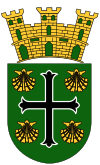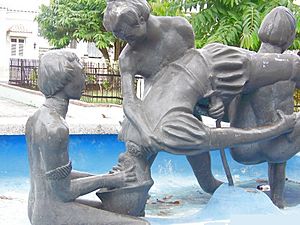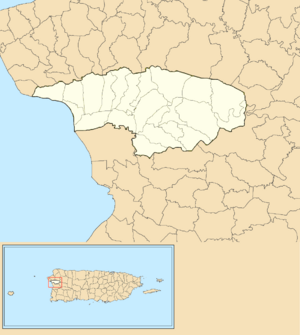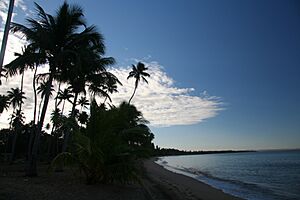Añasco, Puerto Rico facts for kids
Quick facts for kids
Añasco
Municipio Autónomo de Añasco
|
|||
|---|---|---|---|
|
City and municipality
|
|||
|
From top, left to right: Añasco city hall in downtown Añasco; historic Puente Salcedo de Añasco (Salcedo Bridge of Añasco); Bahía de Añasco (Añasco Bay) from Caguabo
|
|||
|
|||
| Nicknames:
"La Ciudad Donde los Dioses Murieron", "El Pueblo Del Hojaldre", "El Pueblo de los Morcilleros", "Los nativos", "La Cuna de la Puertorriqueñidad"
|
|||
| Anthem: "Añasco pueblo querido..." | |||

Map of Puerto Rico highlighting Añasco Municipality
|
|||
| Sovereign state | |||
| Commonwealth | |||
| First settled | 1508 | ||
| Founded | October 18, 1733 | ||
| Founded by | Don Luis de Añasco | ||
| Barrios | |||
| Area | |||
| • Total | 35.5 sq mi (92 km2) | ||
| Population
(2020)
|
|||
| • Total | 25,596 | ||
| • Rank | 47th in Puerto Rico | ||
| • Density | 721.0/sq mi (278.4/km2) | ||
| Demonym(s) | Añasqueños | ||
| Time zone | UTC−4 (AST) | ||
| ZIP Code |
00610
|
||
| Area code(s) | 787/939 | ||
| Major routes | |||
Añasco is a town and municipality located on the west coast of Puerto Rico. It sits next to the Mona Passage and is north of Mayagüez. To its south are Las Marías, and to its north are Rincón, Aguada, and Moca. East of Añasco are San Sebastián and Las Marías. The town is named after Don Luis de Añasco, one of its early settlers.
Contents
- What's in a Name? Añasco's Nicknames
- A Glimpse into Añasco's History
- Exploring Añasco's Geography
- People of Añasco
- Fun Things to Do in Añasco: Tourism
- Añasco's Culture
- Famous People from Añasco
- Añasco's Economy
- Getting Around Añasco: Transportation
- Learning in Añasco: Education
- Añasco's Symbols
- Images for kids
- See also
What's in a Name? Añasco's Nicknames
The name Añasco comes from Don Luis de Añasco. He was an early settler who owned the land where the town was founded. His family name is from Spain, specifically the region of Extremadura.
Añasco has several interesting nicknames:
- "The City Where Gods Die" (La ciudad donde los dioses mueren)
- "The Natives" (Los nativos)
These names refer to a famous legend about a Spanish soldier named Diego Salcedo. In 1511, the native Taíno people drowned him to prove that the Spanish colonizers were not immortal gods. This event led to a revolt.
- "Puff Pastry Town" (Pueblo del Hojaldre)
This nickname comes from the hojaldre, a type of delicious puff pastry that Añasco is famous for.
A Glimpse into Añasco's History
Many historians believe that Christopher Columbus first landed in Puerto Rico in Añasco Bay. This happened during his second voyage on November 19, 1493. He stayed for two days before continuing his journey.
The town of Añasco was officially founded on October 18, 1733. It was named after Don Luis de Añasco, a Spanish colonist who came to Puerto Rico with Juan Ponce de León. A wealthy landowner, Don José de Santiago, helped establish the town on land owned by Don Luis. This land was located near the Guaorabo river, as the Taíno people called it.
Before Añasco, the first settlement in western Puerto Rico was San Germán. It was founded in 1511 near the mouth of the Guaorabo River. However, this early settlement faced many attacks from Carib Indians. Because of these attacks, the people eventually moved further inland to where San Germán is located today.
The Añasco River is also known for the legend of Diego Salcedo. In 1511, the Taíno people drowned him in the river. This event showed that the Spanish soldiers were not gods, and it sparked a revolt.
Many of the first settlers in Añasco came from the Canary Islands and southern Spain. Their culture greatly influenced Puerto Rican traditions, including the local Spanish dialect and architecture.
A major earthquake in 1918, known as the 1918 San Fermín earthquake, caused a lot of damage in Añasco. It destroyed the parish church, the town hall, and many other historic buildings in the downtown area.
More recently, Hurricane Maria hit Puerto Rico on September 20, 2017. This powerful hurricane caused many landslides in Añasco. The Playa barrio was especially affected, with almost all homes being flooded. Many bridges in and around Añasco were also badly damaged.
Exploring Añasco's Geography
Añasco is located in the flat coastal plains of western Puerto Rico. The Río Grande de Añasco borders it. To the north, you'll find Rincón, Aguada, and Moca. To the south is Mayagüez. To the east are San Sebastián and Las Marías. The Mona Passage is to the west.
While Añasco is mostly flat, it also has some hills and mountains. These include Canta Gallo (1,194 feet high) and Gordo and Pichón (both 1,115 feet high). Several rivers flow through Añasco, such as the Icaco River, Caguabo River, and La Balsa.
Añasco's Barrios
Like all municipalities in Puerto Rico, Añasco is divided into smaller areas called barrios. The main town area, with its municipal buildings, central square, and Catholic church, is called "el pueblo".
Here are the 23 barrios of Añasco:
Special Communities
Some communities in Puerto Rico are called "Special Communities" (Comunidades Especiales de Puerto Rico). These are areas where people might face challenges like social exclusion. In Añasco, some of these communities include parts of the Cerro Gordo, Corcovada, Hatillo, Miraflores, and Caguabo barrios. Also, Comunidad La Playa, Parcelas Josefa (Comunidad Espino), Parcelas Marías, Piñales (La Choza), and the Zumbadora sector in Río Arriba barrio are on this list.
People of Añasco
The population of Añasco, like most of Puerto Rico, has roots in the native Taíno people. Later, many immigrants from Spain settled here, especially from the Andalusia and Canary Islands regions. These Spanish settlers greatly influenced the Puerto Rican culture, including the local Spanish accent and the style of buildings.
After the Spanish–American War, Spain gave Puerto Rico to the United States in 1898. The first census by the United States in 1899 showed Añasco had a population of 13,311 people.
| Historical population | |||
|---|---|---|---|
| Census | Pop. | %± | |
| 1900 | 13,311 | — | |
| 1910 | 14,407 | 8.2% | |
| 1920 | 13,834 | −4.0% | |
| 1930 | 14,276 | 3.2% | |
| 1940 | 15,701 | 10.0% | |
| 1950 | 17,235 | 9.8% | |
| 1960 | 17,200 | −0.2% | |
| 1970 | 19,416 | 12.9% | |
| 1980 | 23,274 | 19.9% | |
| 1990 | 25,234 | 8.4% | |
| 2000 | 28,348 | 12.3% | |
| 2010 | 29,261 | 3.2% | |
| 2020 | 25,596 | −12.5% | |
| U.S. Decennial Census 1899 (shown as 1900) 1910-1930 1930-1950 1960-2000 2010 2020 |
|||
Fun Things to Do in Añasco: Tourism
Popular Landmarks and Places to Visit

Añasco is home to 18 beautiful beaches. Tres Hermanos Beach is a very popular one. It was closed for over two years after Hurricane Maria in 2017 but reopened after many repairs.
Other interesting places and beaches in Añasco include:
- Añasco Beach
- Autodrome
- El Salto de la Encantada (a waterfall)
- Hacienda La Eugenia
- Río Grande de Añasco (Añasco Great River)
- San Antonio Abad Parish Church
- Villa Pesquera
To encourage people to explore Puerto Rico during the COVID-19 pandemic in Puerto Rico, the Puerto Rico Tourism Company started the Voy Turistiendo (I'm Touring) campaign in 2021. This campaign included a passport book with a page for each municipality. The Añasco page suggested visiting the Casco Urbano (Urban Center), Mirador de la Bahía (Bay Viewpoint), and restaurants along Puerto Rico Highway 115.
Añasco's Culture
Festivals and Events
Añasco celebrates its patron saint festival in January. The Fiestas Patronales de San Antonio Abad is a religious and cultural event. It usually features parades, games, local crafts, rides, traditional food, and live music.
Other fun festivals and events in Añasco include:
- Mayuco Festival – January
- Fine Arts Festival (Festival de Bellas Artes) – January
- Three Kings Day Festival in Ovejas and Corcovada barrios – January
- Saint Anthony's Marathon – January
- Antique Car Fair – January
- Theater Festival – May
- Youth Festival – July
- Festival in Honor of Saint Rose of Lima – August
- Añasco Triathlon – September
- Chipe Festival – October
Sports in Añasco
Añasco has a AA baseball team called the Fundadores de Añasco. The town is also known for being the home of talented amateur boxing athletes like Samuel Figueroa.
Famous People from Añasco
- Mariana Bracetti (1825–1903) – A patriot and leader in the Puerto Rico independence movement. She is famous for knitting the flag meant to be used if Puerto Rico gained independence from Spain.
- Ivy Queen – A well-known singer.
- Aristides Gonzalez – A boxer who won an Olympic bronze medal in 1984.
- Young Miko – A popular rapper and singer-songwriter.
Añasco's Economy
Historically, sugar cane has been grown in Añasco since the 1500s. One of the earliest known sugar mill operators in the area was Tomás de Castellón in 1523. Añasco has also been important for growing fruits and coffee.
Getting Around Añasco: Transportation
Añasco has 22 bridges. Many of these bridges were damaged when Hurricane Maria hit Puerto Rico on September 20, 2017.
Learning in Añasco: Education
The Puerto Rico Department of Education manages several public schools in Añasco. These include two bilingual schools: Antonio Gonzalez Suarez Regional Bilingual Elementary School and Sergio Ramirez de Arellano-Hostos Regional Bilingual Secondary School. These were the first public bilingual schools on the island! There are also private bilingual schools in Añasco, such as Colegio de la Salle and MAS Integrated School.
Añasco's Symbols
The municipality has an official flag and a coat of arms.
Añasco's Flag
The flag's colors, design, and meaning come directly from Añasco's coat of arms. The only difference is that the silver parts on the coat of arms are white on the flag.
Añasco's Coat of Arms
The shield has a green background with a black cross outlined in silver. In each section formed by the cross, there is a gold scallop shell. Above the shield, there is a gold crown shaped like a wall with three towers.
Images for kids
See also
 In Spanish: Añasco para niños
In Spanish: Añasco para niños




















